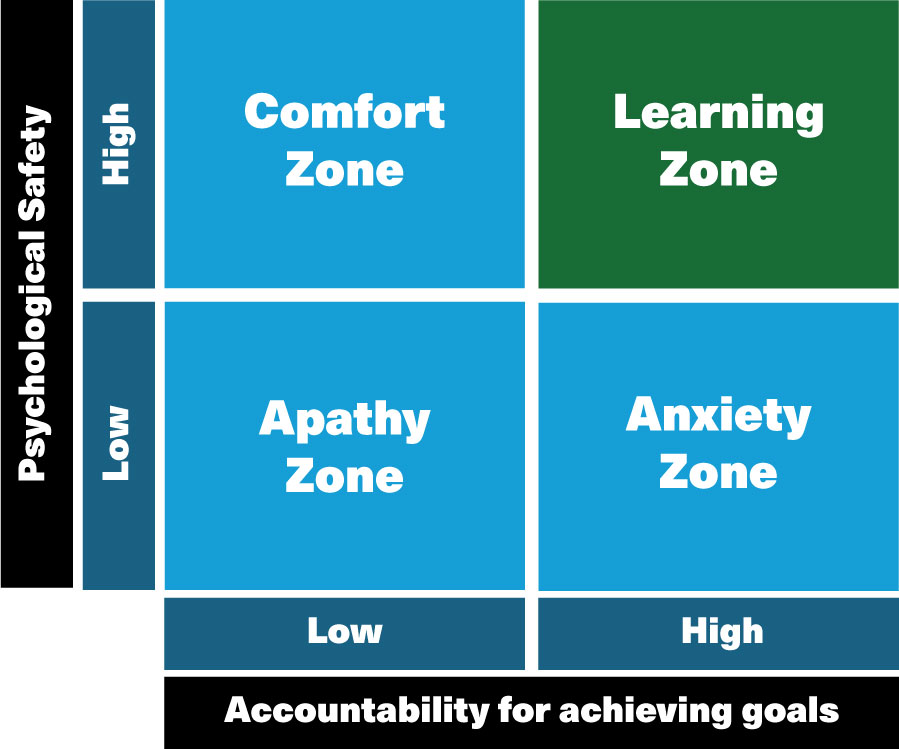
Psychological Safety is not an app that you install and just let run. It’s a practice that ebbs and flows. Human nature often works against it. We get overloaded, hurried, or lazy, and it can get sidetracked for expedience. But if you can define what it means and the desired behaviors for the organization, it can be continually evaluated, improved upon, and maintained.
In a time when organizations need to focus on retention and maximizing their people’s talents, it is surprising that more leaders do not utilize the concept and practices of Psychological Safety.
Many leaders are still not familiar with the term.
We can describe Psychological Safety as how someone feels when deciding if, and what, they share with others – observations, ideas, feelings, and personality.
The evaluation goes like this: “The higher the safety I feel, the more authenticity I will share. The lower the safety I feel, the more guarded or filtered my sharing will be, or I will just stay quiet.”
Advancing Psychological Safety is an initiative that Training can deliver to affect the bottom line. It impacts productivity and efficiency, and it has a significant influence on risk-taking, innovation, and adaptability. Psychological Safety is also correlated to job satisfaction, engagement, and retention.
“It’s not just about feeling safe to speak up,” said Justine Sloyer, PHR, SHRM-SCP. “It’s about using data to ensure every voice is heard and valued.”
As Global Director, Talent Management for Applications Software Technology LLC (AST), Sloyer knows the value of Psychological Safety is tangible, but also cites the importance of measuring interpersonal dynamics and their effects.
“Putting numbers to intangibles like Psychological Safety is a game-changer,” said Sloyer.
How do you measure what you can’t see?
Psychological Safety isn’t easily seen, but its results are observable.
“We’ve seen it drive business outcomes and create a work environment where individuals and teams thrive,” said Sloyer.
Because of this, it is important to focus on making Psychological Safety practices more tangible and apparent to team members and the organization.

The four zones above are used when talking about psychological safety and accountability.
What follows will explain how to break down key identifiable elements of Psychological Safety to practices that can be surveyed, measured, and acted upon.
Queries might include:
• In this group, making an error is not looked down upon and held against you (rank from very much agree to very much disagree).
- In this group, I feel comfortable voicing concerns and what I see as critical challenges (ranging from very much agree to very much disagree).
Applying the newly actionable information
Once the framework, language, and measurement are in place, leaders can take steps to increase Psychological Safety in the lower areas and work to maintain the higher areas.
As an example, let’s look at the assessment query above: “In this group, making an error is not looked down upon and held against you.”
We don’t want errors, but they happen, causing finger-pointing, yelling, or passive-aggressive silence. More positively, they can create teachable moments. If we refer to the four zones of Psychological Safety and our group is in the Learning Zone, we will be comfortable discussing the scenario and how to learn, grow, and improve.
In a culture with low Psychological Safety, errors may be brought to light negatively in public, held over your head, and you could be labeled in the future. That puts the group in the Anxiety Zone, leading to decreased interpersonal risk-taking and choosing work that is more status quo, near-term, or incremental.
In a psychologically safe context, people ask, “How did this error occur? Where did the error derive from? How can we learn from this and be stronger next time?”
Consider the second query example: “In this group, I feel comfortable voicing concerns and what I see as critical challenges.”
When someone provides their opinion, that person is taking on a risk.
If someone has used their brain power to analyze the current situation, call out a gap, or offer a more effective way forward, they are investing in their work. Leaders need to reinforce that behavior positively.
When people have negative experiences sharing concerns, they can shift into “Whatever” mode and the Apathy Zone. Their thinking is like this: “Something may be wrong, but I could get negatively called out for voicing my concern. It doesn’t matter if I point it out; the leader won’t hear me, or they won’t act on what I say. I will just be quiet and hit the mute button.”
This “Whatever” mode decreases accountability, caring, and the sharing of future concerns, pushing the group into the Apathy Zone.
Summary
There is no Psychological Safety thermostat, but you can detect the level of Psychological Safety in the team or organization you are in. When safety is high, there is more cohesion, better effort, and deeper relationships. The level of trust, openness, and people who take responsibility for their work is much greater. When safety is low, the inverse occurs.
It takes time and energy, but all groups can work toward becoming high performers in Psychological Safety by:
- Defining what Psychological Safety means and looks like behaviorally for a group
- There are many definitions to use, including those in this article.
- Measuring Psychological Safety. Get a gauge on how a group is feeling. Take a pulse at least twice per year.
- Develop an action plan so that the practices that maintain psychological safety can propagate throughout the organization.
If organizations do these three things for Psychological Safety, they will see increases in performance, retention, leadership, morale, adaptability, and the quality and uniqueness of ideas that people share.




